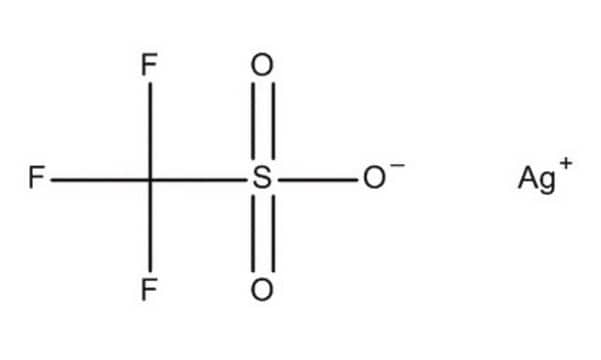674583
Silver perchlorate
anhydrous, 97%
Synonym(s):
Perchloric acid silver(1+) salt, Silver(1+) perchlorate
About This Item
Recommended Products
grade
anhydrous
Assay
97%
form
solid
reaction suitability
reagent type: catalyst
core: silver
impurities
≤0.1% Insoluble matter
mp
486 °C (lit.)
solubility
benzene: slightly soluble(lit.)
pyridine: slightly soluble(lit.)
density
2.8 g/mL at 25 °C (lit.)
SMILES string
[Ag+].[O-]Cl(=O)(=O)=O
InChI
1S/Ag.ClHO4/c;2-1(3,4)5/h;(H,2,3,4,5)/q+1;/p-1
InChI key
YDHABVNRCBNRNZ-UHFFFAOYSA-M
Looking for similar products? Visit Product Comparison Guide
Application
- Anion exchange dynamics in the capture of perchlorate by a cationic Ag-based MOF: Investigates the anion exchange dynamics and structural transformations of a silver-based metal-organic framework capturing perchlorate (Colinas et al., 2017).
Signal Word
Danger
Hazard Statements
Precautionary Statements
Hazard Classifications
Ox. Sol. 2 - Skin Corr. 1B
Storage Class Code
5.1A - Strongly oxidizing hazardous materials
WGK
WGK 3
Flash Point(F)
Not applicable
Flash Point(C)
Not applicable
Personal Protective Equipment
Certificates of Analysis (COA)
Search for Certificates of Analysis (COA) by entering the products Lot/Batch Number. Lot and Batch Numbers can be found on a product’s label following the words ‘Lot’ or ‘Batch’.
Already Own This Product?
Find documentation for the products that you have recently purchased in the Document Library.
Customers Also Viewed
Articles
We are proud to offer a treasure-trove of gold precatalysts and silver salts, as well as an extensive portfolio of unsaturated building blocks to accelerate your research success in this exciting field.
Plasmonic nanoparticles have unique optical properties that can be tailored to suit a variety of applications in the biotechnology1–8 and electronics9–16 industries.
Plasmonic nanoparticles have unique optical properties that can be tailored to suit a variety of applications in the biotechnology1–8 and electronics9–16 industries.
Plasmonic nanoparticles have unique optical properties that can be tailored to suit a variety of applications in the biotechnology1–8 and electronics9–16 industries.
Our team of scientists has experience in all areas of research including Life Science, Material Science, Chemical Synthesis, Chromatography, Analytical and many others.
Contact Technical Service













